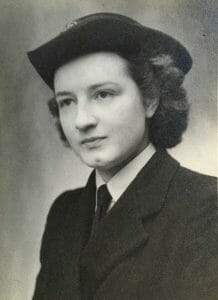
As a young teen, Baker was evacuated from London in the runup to World War II as “Operation Pied Piper” took children to safety, first to Ipswich, and later Blaengarw, Wales. But at 18, she joined the war effort. “In 1943 I decided I wanted to join the Wrens,” she said — the Women’s Royal Naval Service, and was assigned to Eastcoate, a London outstation of Bletchley Park codebreaking operation. Baker worked on the Bombe — an electro-mechanical computer designed by Alan Turing, based on prior work in Poland (the bomba kryptologiczna or cryptologic bomb), to break the German Enigma cypher machine. Enigma was used to encrypt messages from Berlin to German commanders, submarines, and other field units, which the Nazis were confident were unbreakable. “We worked in eight-hour shifts. When the machine stopped, we’d take down the numbers and give them to a partner, who operated a checking machine,” she said.

“When successful, their codebreaking efforts could have a monumental impact on the war effort,” declared the London Guardian. “The decoding of one message led to the location of the Scharnhorst, one of Germany’s most famous battleships, being revealed. Allied forces were then able to attack and defeat the ship in the Battle of the North Cape, off Norway.” Once the war in Europe ended, VE Day, Baker was reassigned to the main codebreaking facility, Bletchley Park, to similarly work on decrypting Japanese communications. The operation, of course, was top secret. After the war, Baker married Joe Aylard — and even didn’t tell him what she did during the war for about 20 years. “Most of my family didn’t know what I did,” Mrs. Aylard said, “just that it was something important. It wasn’t until 1974, with the publication of a book about Bletchley Park, that anyone learned what went on behind the scenes.” She had gone on to study at the London School of Economics, and taught that subject at Queens Girls School. Joyce Ethel Baker Aylard died October 16, at 97.
